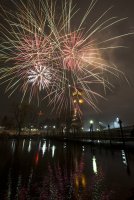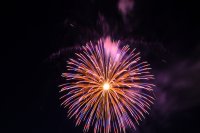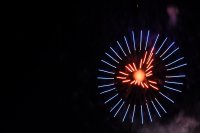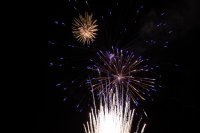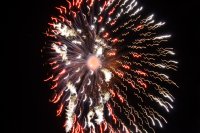Last night I had a chance to practice my fireworks technique.
As I did, I discovered something I hadn't realized before.
After about 3 seconds, shutter speed is irrelevent as it relates to the fireworks! Aperture is what's really important for exposing the bursts, and once it's dialed in, you can vary your shutter speed as you see fit. What? Am I nuts? No, there's logic behind this.
The typical pro fireworks burst only lasts about 2 to 3 seconds. Then the powder burns out and it fades to black. So 4 seconds or 10 seconds, if the burst only is visible for 3, it doesn't matter.
The fireworks is basically setting the shutter speed for its part of the exposure with its duration. You can't vary the brightness of the bursts. (They do vary, sometimes by quite a lot, but as a photographer you cannot control it, you can only adjust for it.) So, since the exposure duration is effectively set by the shells burn time, you can only control the aperture and ISO. Set those to try and keep some color in the fireworks. I found between f11 and f8 at ISO 200 worked well. Which setting is best depends on the shell's brightness and your distance.
After dialing the aperture in, I varied my shutter speed from 6 to 20 seconds. It didn't affect the color of the individual bursts. Obviously, if you get too many bursts in the same spot, you'll get an over-exposed white blob. Also, if there's enough ambient light, the shutter speed will control how visible the foreground and background is.
So you should set both shutter speed and aperture according to your local conditions, but what I hadn't thought much about is that they're don't directly correlate when it relates to the fireworks themselves. Your setting for the aperture will be based on the brightness of the fireworks, while shutter speed should be based on how many shells they're shooting and the frequency. Unlike most photos, you can change one without changing the other and get roughly the same exposure for the bursts. However, changing shutter speed will affect how the rest of the shot looks.
Obviously, the exposure for the foreground will vary depending on the shutter speed you use. Also, how many bursts you get in each shot will be determined by shutter speed. Get too many, and you'll get a white blob.
Basically here's what I'm suggesting, assuming you're using a tripod and shooting the entire burst of the shell rather than a short exposure.
1) Select your ISO, I went with a fairly low one, for best resolution. I think it was ISO 200, though I didn't verify that.
2) Dial in the exposure of the firework with aperture.
3) Using shutter speed, expose for the rest of the scene and/or choose how many burst you capture. Note that as I mentioned above, the fireworks itself is essentially setting it's own shutter speed, since it goes out after 3 seconds. You are controlling the exposure for the rest of the scene, for example city lights or in summer shows, capturing the last dark blue of the sky.
The fact the last two work somewhat independently (for the fireworks burst) surprised me. The key to remember is that a shell that only lasts for 3 seconds is effectively setting its own shutter speed of 3 seconds, no matter what you have dialed in on the camera.
Also, keep in mind that the traditional fireworks shape doesn't really exist. It's caused by dots of bright light "painting" on the film/sensor. They move during the exposure, creating the dandelion seed shape we're familiar with. So you're actually trying to set the exposure for a brightly light object that's in motion. Because of that, you made need a higher ISO or a larger aperture than you'd expect for a long exposure.
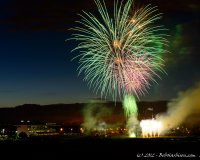
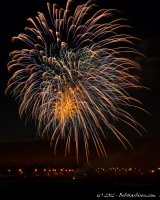
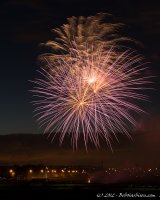
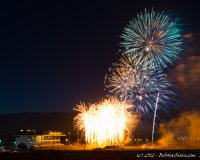
As I did, I discovered something I hadn't realized before.
After about 3 seconds, shutter speed is irrelevent as it relates to the fireworks! Aperture is what's really important for exposing the bursts, and once it's dialed in, you can vary your shutter speed as you see fit. What? Am I nuts? No, there's logic behind this.
The typical pro fireworks burst only lasts about 2 to 3 seconds. Then the powder burns out and it fades to black. So 4 seconds or 10 seconds, if the burst only is visible for 3, it doesn't matter.
The fireworks is basically setting the shutter speed for its part of the exposure with its duration. You can't vary the brightness of the bursts. (They do vary, sometimes by quite a lot, but as a photographer you cannot control it, you can only adjust for it.) So, since the exposure duration is effectively set by the shells burn time, you can only control the aperture and ISO. Set those to try and keep some color in the fireworks. I found between f11 and f8 at ISO 200 worked well. Which setting is best depends on the shell's brightness and your distance.
After dialing the aperture in, I varied my shutter speed from 6 to 20 seconds. It didn't affect the color of the individual bursts. Obviously, if you get too many bursts in the same spot, you'll get an over-exposed white blob. Also, if there's enough ambient light, the shutter speed will control how visible the foreground and background is.
So you should set both shutter speed and aperture according to your local conditions, but what I hadn't thought much about is that they're don't directly correlate when it relates to the fireworks themselves. Your setting for the aperture will be based on the brightness of the fireworks, while shutter speed should be based on how many shells they're shooting and the frequency. Unlike most photos, you can change one without changing the other and get roughly the same exposure for the bursts. However, changing shutter speed will affect how the rest of the shot looks.
Obviously, the exposure for the foreground will vary depending on the shutter speed you use. Also, how many bursts you get in each shot will be determined by shutter speed. Get too many, and you'll get a white blob.
Basically here's what I'm suggesting, assuming you're using a tripod and shooting the entire burst of the shell rather than a short exposure.
1) Select your ISO, I went with a fairly low one, for best resolution. I think it was ISO 200, though I didn't verify that.
2) Dial in the exposure of the firework with aperture.
3) Using shutter speed, expose for the rest of the scene and/or choose how many burst you capture. Note that as I mentioned above, the fireworks itself is essentially setting it's own shutter speed, since it goes out after 3 seconds. You are controlling the exposure for the rest of the scene, for example city lights or in summer shows, capturing the last dark blue of the sky.
The fact the last two work somewhat independently (for the fireworks burst) surprised me. The key to remember is that a shell that only lasts for 3 seconds is effectively setting its own shutter speed of 3 seconds, no matter what you have dialed in on the camera.
Also, keep in mind that the traditional fireworks shape doesn't really exist. It's caused by dots of bright light "painting" on the film/sensor. They move during the exposure, creating the dandelion seed shape we're familiar with. So you're actually trying to set the exposure for a brightly light object that's in motion. Because of that, you made need a higher ISO or a larger aperture than you'd expect for a long exposure.




Last edited:

